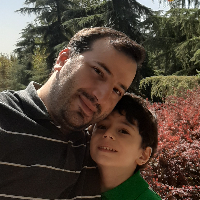Future and paleo changes in Mid-Latitude Westerlies and Mediterranean winter precipitation system over Kerman province: A case study Kahnuj synoptic station
Global warming refers to the recent and ongoing rise in global average temperature near Earth's surface. It is caused mostly by increasing concentrations of greenhouse gases in the atmosphere. Global warming is causing climate patterns to change. However, global warming itself represents only one aspect of climate change. (Nakicenovic et al., 2000; Bytnerowicz et al., 2007).Over the past century, human activities have released large amounts of carbon dioxide and other greenhouse gases into the atmosphere. The majority of greenhouse gases come from burning fossil fuels to produce energy, although deforestation, industrial processes, and some agricultural practices also emit gases into the atmosphere.Greenhouse gases act like a blanket around Earth, trapping energy in the atmosphere and causing it to warm. This phenomenon is called the greenhouse effect and is natural and necessary to support life on Earth. However, the buildup of greenhousegases can change Earth's climate and result in dangerous effects to human health and welfare and to ecosystems.
In this study, daily precipitation and daily maximum (Tmax) and daily minimum (Tmin) temperatures in the Kahnuj synoptic station, southeastern Iran were predicted for the future (2061-2080) by statistical downscaling outputs of 5 GCM models (EC-EARTH, GFDL-CM3, HadGEM2-ES, MIROC5, MPI-ESM-MR) under RCP 4.5 and RCP 8.5 emission scenarios.
The results of statistical downscaling outputs of 5 GCM models by LARS-WG model under RCP 8.5 emission scenarios (the business-as-usual) in Kahnuj station was modeled from 2061–2080. During this period the mean temperature will increase between 3.2 to 4.6 °C compared to the base period.At The Paris Agreement, the average increase in temperature was set at below 2 °C by the end of the 21st century, which includes the 0.9 °C increase Since the Industrial Revolution, to avoid adverse and unpredictable weather effects (IPCC, 2021; Millar et al., 2017; Rogelj et al., 2018). However, the results of this study show that southeastern Iran is firmly set on the path by increasing the current temperature by several degrees more by 2080. Based on the two modeled scenarios, the change in temperature will have an increasing trend in the coming years and is in good agreement with the recent assessments of future temperature changes in southwest Asia (Babar et al., 2016; Hamidianpour et al., 2016; Pal et al., 2016; Evans, 2009). Therefore, if greenhouse gas emissions continue at their present rate, earth's surface temperature in this region will pass the temperature threshold of 2 °C.
We compare simulated future precipitation based on RCP 4.5 and RCP 8.5 scenarios of global warming with real paleoclimatic changes that happened in the region. In this respect, the maximum and minimum temperatures and precipitation projection in the southeastern Iran is derived from the downscaling of the CMIP5 GCMs (EC-EARTH, GFDL-CM3, HadGEM2-ES, MIROC5, and MPI-ESM-MR) under RCP 4.5 and RCP 8.5 using the Lars WG model. Paleoenvironmental records from southeastern Iran is used to examine whether the predicted changes in precipitation and variability in MLW output based on the two scenarios of global warming are valid.GCMs predicted a considerable decrease in MLW precipitation in Kahnuj station. Similarly, HadGEM2-ES and GFDL-CM3 indicate a weak decline in precipitation compared to other GCMs at the Kahnuj station for RCP 8.5.The current study indicates that in the Jazmurian playa, MLW precipitation will decrease, and temperature will increase in future simulations. Infact, Consistent with several GCM studies and real paleoclimatic changes that happened during past warm/wet periods in the region, results emerging from the Jazmurian playa also show a weakening of the MLW under the RCP 8.5.
- حق عضویت دریافتی صرف حمایت از نشریات عضو و نگهداری، تکمیل و توسعه مگیران میشود.
- پرداخت حق اشتراک و دانلود مقالات اجازه بازنشر آن در سایر رسانههای چاپی و دیجیتال را به کاربر نمیدهد.



